Effects of Second Phases on Microstructure, Microhardness, and Corrosion Behavior of Mg-3Sn-(1Ca) Alloys
Abstract
:1. Introduction
2. Materials and Methods
3. Results and Discussion
4. Conclusions
- (1)
- The Mg2Sn phases of Mg-3Sn alloy were decomposed in the α-Mg matrix, and the microstructure of Mg-3Sn-1Ca alloy remained essentially unchanged after solution treatment for 28 h at 733 K, suggesting that the thermal stability of the CaMgSn phase is evidently higher compared to that of the Mg2Sn phase.
- (2)
- The Mg-3Sn alloy exhibited double age-hardening peaks. The microhardness increased to a first peak value of 54.9 ± 2.1 HV at 7 h with the increase in aging times. After a slight decrease, the microhardness increased again to a second peak value of 57.4 ± 2.8 HV for 15 h. The microhardness of aged Mg-3Sn-1Ca alloy quickly reached a stable value with the increasing aging times due to the no change of CaMgSn phases.
- (3)
- The corrosion resistance of aged Mg-3Sn alloy was obviously better compared to aged Mg-3Sn-1Ca alloy, especially Mg-3Sn alloy aged for 7 h. The most of dissolved Sn atoms and a small quantity of tiny Mg2Sn particles made the corrosion film composed of SnO2 become denser, and inhibited further corrosion of the alloy. However, a significant number of galvanic cells formed between α-Mg and a large number of CaMgSn phases accelerated the corrosion of aged Mg-3Sn-1Ca alloy.
Author Contributions
Funding
Acknowledgments
Conflicts of Interest
References
- Makar, G.L.; Kruger, J. Corrosion of magnesium. Int. Mater. Rev. 1993, 38, 138–153. [Google Scholar] [CrossRef]
- Pan, F.S.; Yang, M.B.; Chen, X.H. A review on casting magnesium alloys: Modification of commercial alloys and development of new alloys. J. Mater. Sci. Technol. 2016, 32, 1211–1221. [Google Scholar] [CrossRef]
- Cui, Y.J.; Li, Y.P.; Sun, S.H.; Bian, H.K.; Huang, H.; Wang, Z.C.; Koizumi, Y.; Chiba, A. Enhanced damping capacity of magnesium alloys by tensile twin boundaries. Scr. Mater. 2015, 101, 8–11. [Google Scholar] [CrossRef]
- Wang, C.M.; Cui, Z.M.; Liu, H.M.; Chen, Y.G.; Ding, W.C.; Xiao, S.F. Electrical and thermal conductivity in Mg–5Sn alloy at different aging status. Mater. Des. 2015, 84, 48–52. [Google Scholar] [CrossRef]
- Luo, A.A. Recent magnesium alloy development for elevated temperature applications. Int. Mater. Rev. 2004, 49, 13–30. [Google Scholar] [CrossRef]
- Kang, D.H.; Park, S.S.; Kim, N.J. Development of creep resistant die cast Mg-Sn-Al-Si alloy. Mater. Sci. Eng. A 2005, 413–414, 555–560. [Google Scholar] [CrossRef]
- Gibson, M.A.; Fang, X.; Bettles, C.J.; Hutchinson, C.R. The effect of precipitate state on the creep resistance of Mg-Sn alloys. Scr. Mater. 2010, 63, 899–902. [Google Scholar] [CrossRef]
- Liu, H.M.; Chen, Y.G.; Tang, Y.B.; Wei, S.H.; Niu, G. The microstructure, tensile properties, and creep behavior of as-cast Mg-(1–10)% Sn alloys. J. Alloy. Compd. 2007, 440, 122–126. [Google Scholar] [CrossRef]
- Ha, H.Y.; Kang, J.Y.; Kim, S.G.; Kim, B.; Park, S.S.; Yim, C.D.; You, B.S. Influences of metallurgical factors on the corrosion behaviour of extruded binary Mg–Sn alloys. Corros. Sci. 2014, 82, 369–379. [Google Scholar] [CrossRef]
- Kozlov, A.; Ohno, M.; Arroyave, R.; Liu, Z.K.; Schmid-Fetzer, R. Phase equilibria, thermodynamics and solidification microstructures of Mg-Sn-Ca alloys, Part 1: Experimental investigation and thermodynamic modeling of the ternary Mg-Sn-Ca system. Intermetallics 2008, 16, 299–315. [Google Scholar] [CrossRef]
- Nayyeri, G.; Mahmudi, R. Effects of Ca additions on the microstructural stability and mechanical properties of Mg-5% Sn alloy. Mater. Des. 2011, 32, 1571–1576. [Google Scholar] [CrossRef]
- Wang, C.M.; Liu, Z.Z.; Xiao, S.F.; Chen, Y.G. Effects of Sn, Ca additions on thermal conductivity of Mg matrix alloys. Mater. Sci. Technol. 2016, 32, 581–587. [Google Scholar] [CrossRef]
- Khalilpour, H.; Mahdi Miresmaeili, S.; Baghani, A. The microstructure and impression creep behavior of cast Mg-4Sn-4Ca alloy. Mater. Sci. Eng. A 2016, 652, 365–369. [Google Scholar] [CrossRef]
- Ast, J.; Ghidelli, M.; Durst, K.; Goken, M.; Sebastiani, M.; Korsunsky, A.M. A review of experimental approaches to fracture toughness evaluation at the micro-scale. Mater. Des. 2019, 173, 107762. [Google Scholar] [CrossRef]
- Ghidelli, M.; Sebastiani, M.; Collet, C.; Guillemet, R. Determination of the elasticmoduli and residual stresses of freestanding Au-TiW bilayer thin films by nanoindentation. Mater. Des. 2016, 106, 436–445. [Google Scholar] [CrossRef]
- Li, Z.J.; Gu, X.N.; Lou, S.Q.; Zheng, Y.F. The development of binary Mg-Ca alloys for use as biodegradable materials within bone. Biomaterials 2008, 29, 1329–1344. [Google Scholar] [CrossRef] [PubMed]
- Zeng, R.C.; Qi, W.C.; Cui, H.Z.; Zhang, F.; Li, S.Q.; Han, E.H. In vitro corrosion of as-extruded Mg-Ca alloys-The influence of Ca concentration. Corros. Sci. 2015, 96, 23–31. [Google Scholar] [CrossRef]
- Cao, F.Y.; Shi, Z.M.; Song, G.L.; Liu, M.; Atrens, A. Corrosion behaviour in salt spray and in 3.5% NaCl solution saturated with Mg(OH)2 of as-cast and solution heat-treated binary Mg-X alloys: X = Mn, Sn, Ca, Zn, Al, Zr, Si, Sr. Corros. Sci. 2013, 76, 60–97. [Google Scholar] [CrossRef]
- Liu, X.B.; Shan, D.Y.; Song, Y.W.; Chen, R.S.; Han, E.H. Influences of the quantity of Mg2Sn phase on the corrosion behavior of Mg-7Sn magnesium alloy. Electrochim. Acta 2011, 56, 2582–2590. [Google Scholar] [CrossRef]
- Moon, S.; Nam, Y. Anodic oxidation of Mg-Sn alloys in alkaline solutions. Corros. Sci. 2012, 65, 494–501. [Google Scholar] [CrossRef]
- Wang, J.F.; Li, Y.; Huang, S.; Zhou, X.E. Study of the corrosion behavior and the corrosion films formed on the surfaces of Mg-xSn alloys in 3.5 wt.% NaCl solution. Appl. Surf. Sci. 2014, 317, 1143–1150. [Google Scholar] [CrossRef]
- Yang, J.; Yim, C.D.; You, B.S. Effects of Sn in α-Mg matrix on properties of surface films of Mg-xSn (x = 0, 2, 5 wt%) alloys. Mater. Corros. 2016, 67, 531–541. [Google Scholar] [CrossRef]
- Ha, H.Y.; Kang, J.Y.; Yang, J.; Yim, C.D.; You, B.S. Role of Sn in corrosion and passive behavior of extruded Mg-5 wt% Sn alloy. Corros. Sci. 2016, 102, 355–362. [Google Scholar] [CrossRef]
- Cain, T.W.; Glover, C.F.; Scully, J.R. The corrosion of solid solution Mg-Sn binary alloys in NaCl solutions. Electrochim. Acta 2019, 297, 564–575. [Google Scholar] [CrossRef]
- Leil, T.A.; Hort, N.; Dietzel, W.; Blawert, C.; Huang, Y.; Kainer, K.U.; Rao, K.P. Microstructure and corrosion behavior of Mg-Sn-Ca alloys after extrusion. Trans. Nonferr. Met. Soc. China 2009, 19, 40–44. [Google Scholar] [CrossRef]
- Zhao, C.Y.; Pan, F.S.; Pan, H.C. Microstructure, mechanical and bio-corrosion properties of as-extruded Mg-Sn-Ca alloys. Trans. Nonferr. Met. Soc. China 2016, 26, 1574–1582. [Google Scholar] [CrossRef]
- Liu, Q.; Cheng, W.L.; Zhang, H.; Xu, C.X.; Zhang, J.S. The role of Ca on the microstructure and corrosion behavior of Mg-8Sn-1Al-1Zn-Ca alloys. J. Alloy. Compd. 2014, 590, 162–167. [Google Scholar] [CrossRef]
- Yang, L.; Guo, S.; Li, G.Y.; Nie, X.P.; Yang, M.N.; Wang, C.M. The microstructure, mechanical properties and corrosion behavior of Ce-containing Mg-3Sn-1Ca alloy. Mater. Sci. Technol. 2019, 35, 946–952. [Google Scholar] [CrossRef]
- Kim, J.M.; Mousa, H.; Park, C.H.; Kim, C.S. Enhanced corrosion resistance and biocompatibility of AZ31 Mg alloy using PCL/ZnO NPs via electrospinning. Appl. Surf. Sci. 2017, 396, 249–258. [Google Scholar] [CrossRef]
- Cho, D.H.; Lee, B.W.; Park, J.Y.; Cho, K.M.; Park, I.M. Effect of Mn addition on corrosion properties of biodegradable Mg-4Zn-0.5Ca-xMn alloys. J. Alloy. Compd. 2017, 695, 1166–1174. [Google Scholar] [CrossRef]
- Liu, J.H.; Han, E.H.; Song, Y.W.; Shan, D.Y. Effect of twins on the corrosion behavior of Mg-5Y-7Gd-1Nd-0.5Zr Mg alloy. J. Alloy. Compd. 2018, 757, 356–363. [Google Scholar] [CrossRef]
- King, A.D.; Birbilis, N.; Scully, J.R. Accurate electrochemical measurement of magnesium corrosion rates: A combined impedance, mass-loss and hydrogen collection study. Electrochem. Acta 2014, 121, 394–406. [Google Scholar] [CrossRef]
- Phuong, N.V.; Gupta, M.; Moon, S. Enhanced corrosion performance of magnesium phosphate conversion coating on AZ31 magnesium alloy. Trans. Nonferr. Met. Soc. China 2017, 27, 1087–1095. [Google Scholar] [CrossRef]
- Wang, C.M.; Liu, H.M.; Chen, Y.G.; Xiao, S.F. Effect of precipitates on thermal conductivity of aged Mg-5Sn alloy. Philos. Mag. 2017, 97, 1698–1707. [Google Scholar] [CrossRef]
- Gu, M.; Wei, G.; Zhao, J.; Liu, W.; Wu, G. Influence of yttrium addition on the corrosion behaviour of as-cast Mg-8Li-3Al-2Zn alloy. Mater. Sci. Technol. 2017, 33, 864–869. [Google Scholar] [CrossRef]
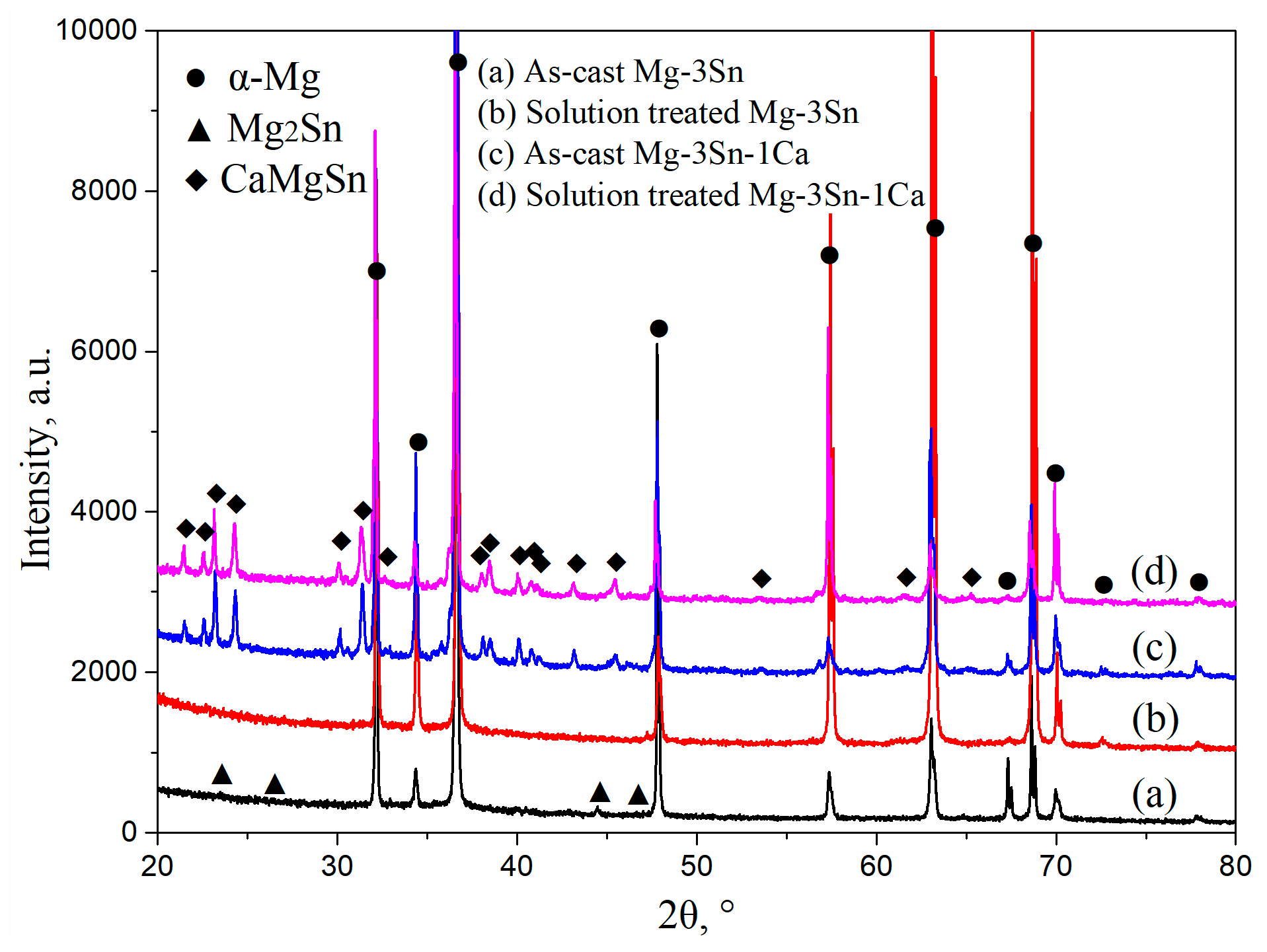


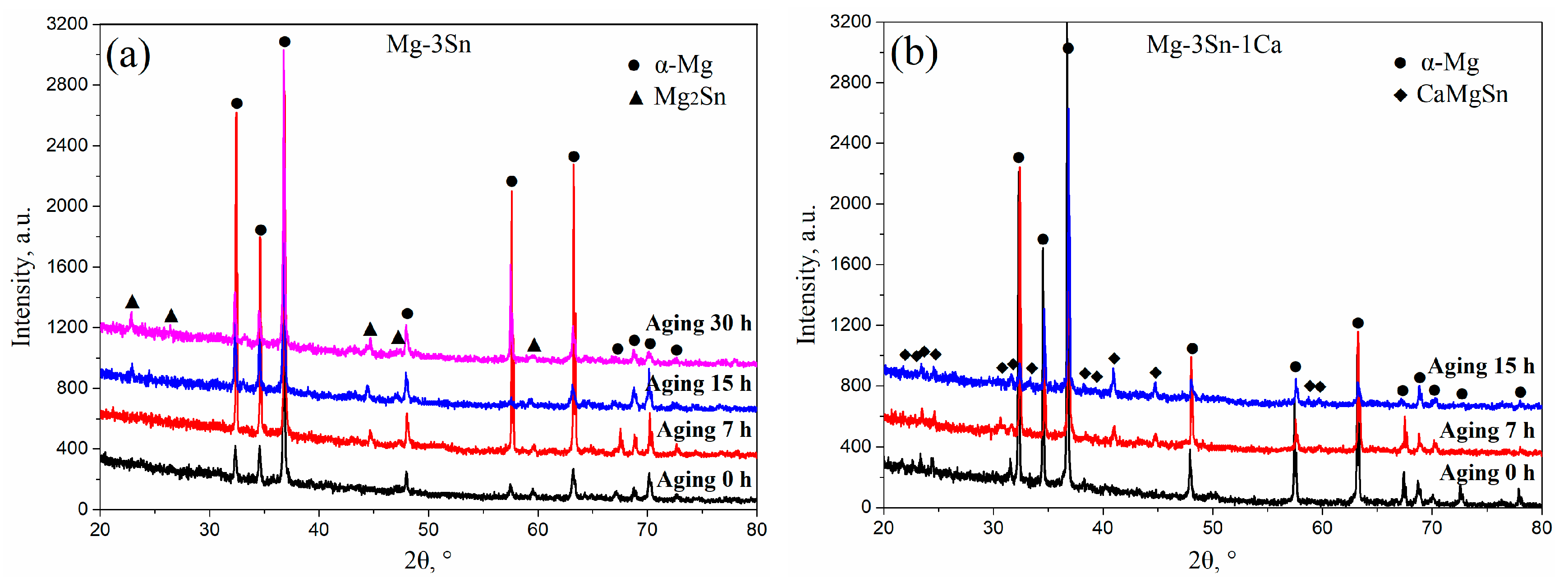
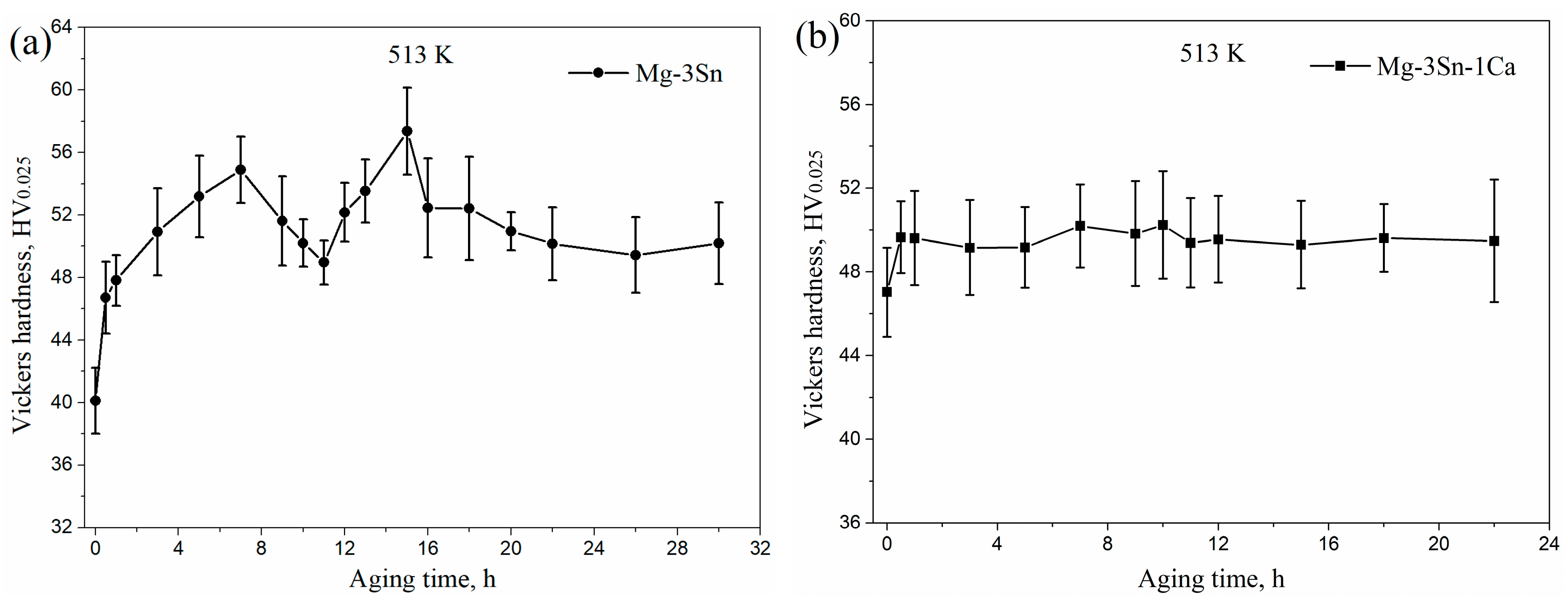

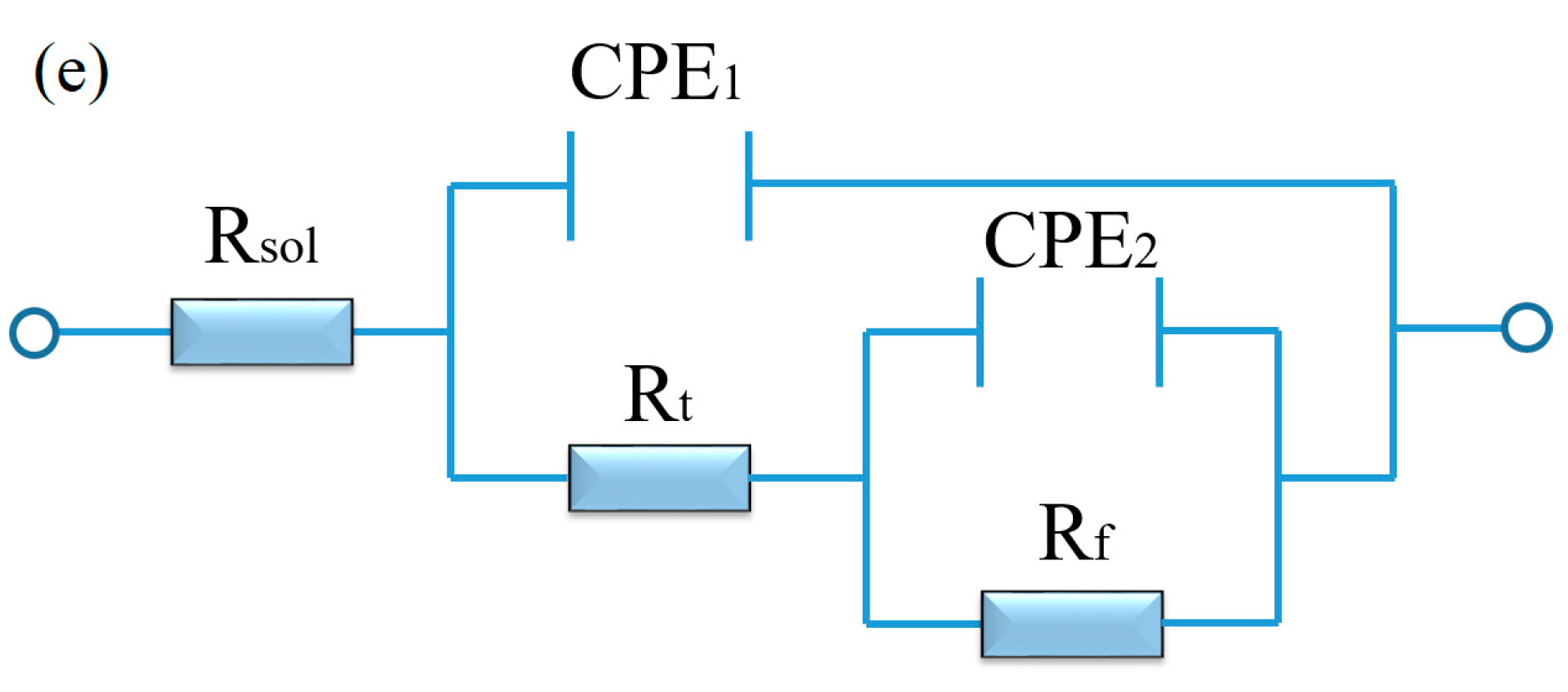

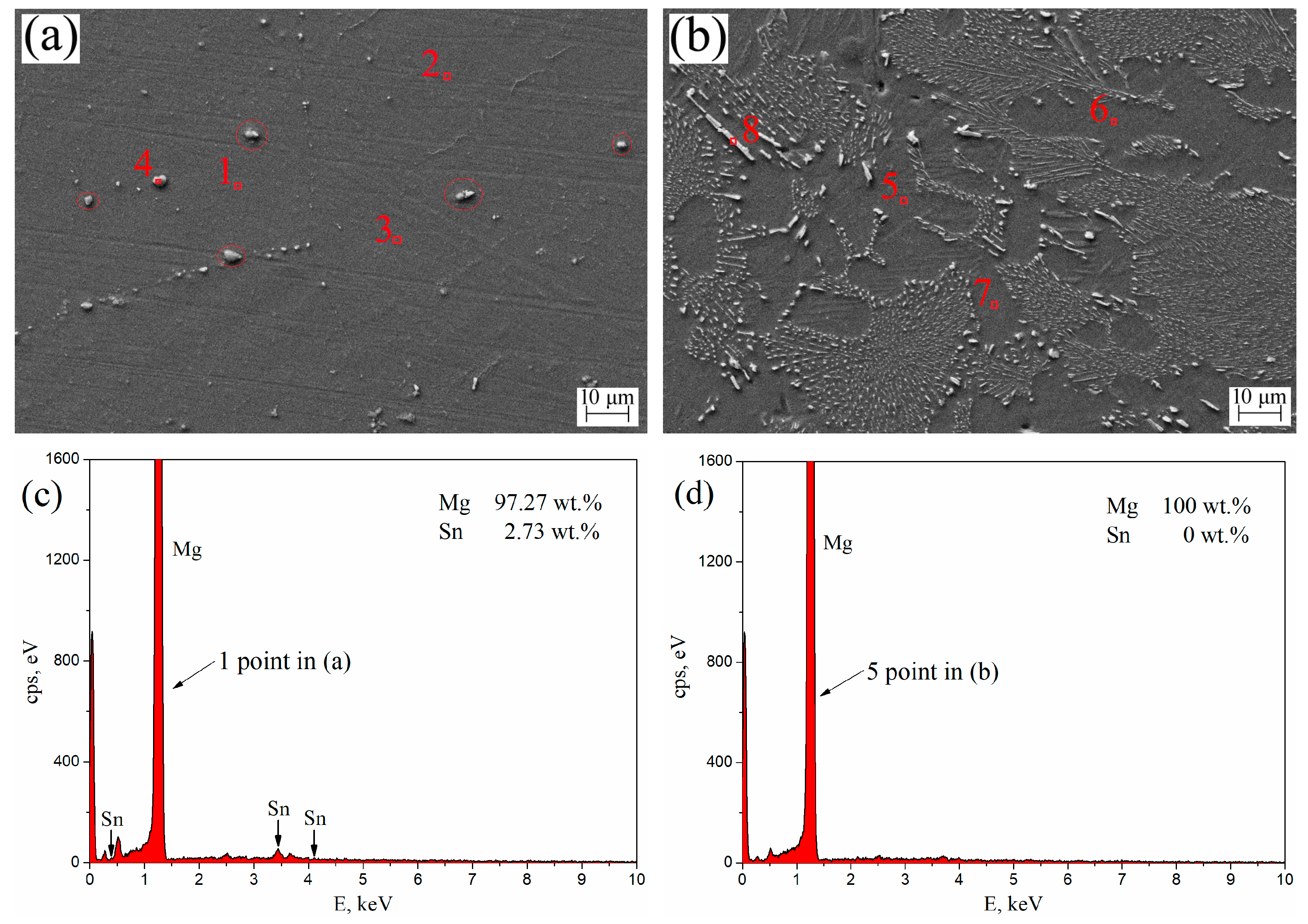

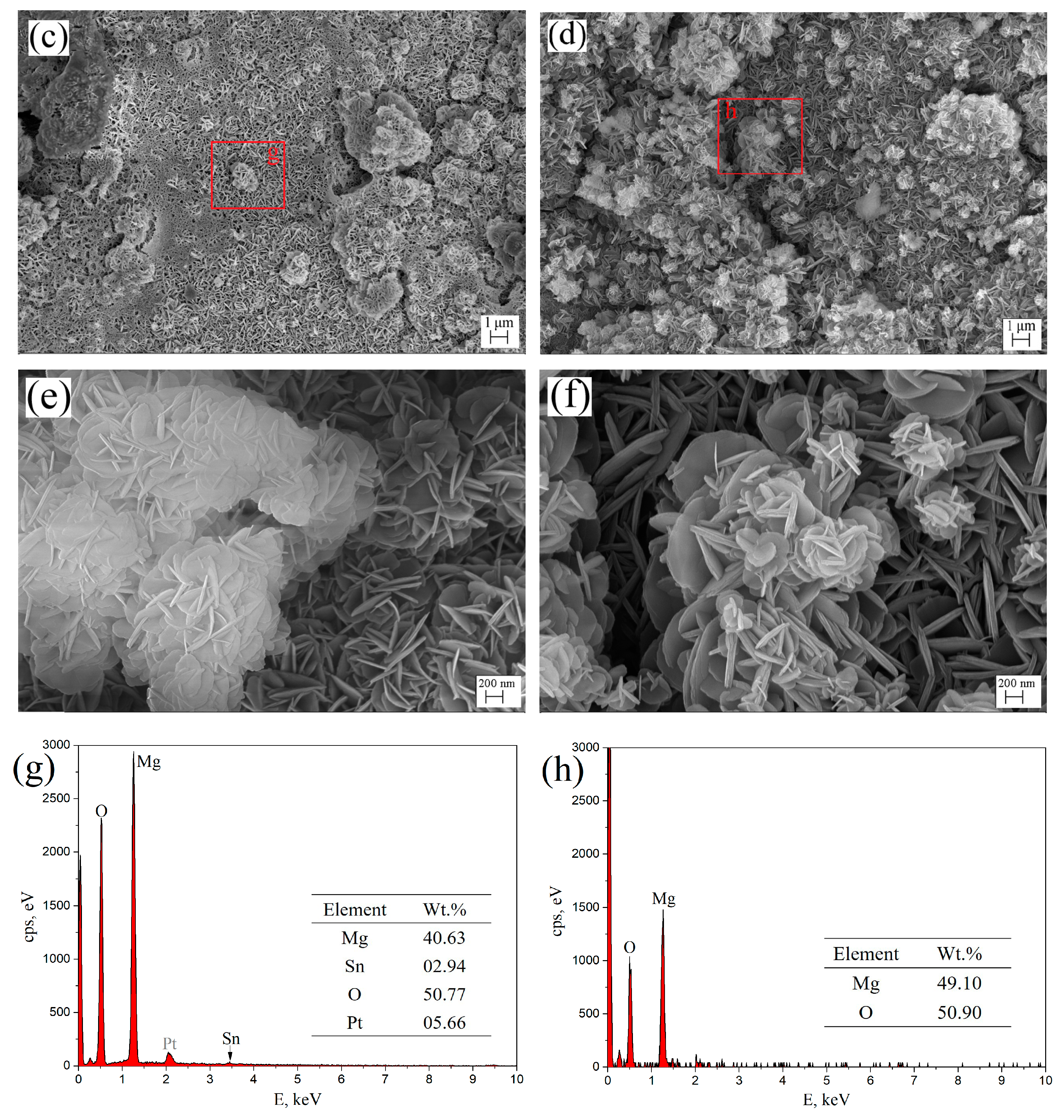

| Specimen | Rsol (Ω·cm2) | CPE1 (F/cm2) | n1 | Rt (Ω·cm2) | CPE2 (F/cm2) | n2 | Rf (Ω·cm2) |
|---|---|---|---|---|---|---|---|
| T3, 0 h | 4.931 | 1.543 × 10−5 | 0.9322 | 950.9 | 0.934 × 10−3 | 0.5128 | 480.6 |
| T3, 7 h | 5.463 | 1.572 × 10−5 | 0.9246 | 1123 | 1.284 × 10−3 | 0.5877 | 425.9 |
| T3, 15 h | 4.236 | 1.340 × 10−5 | 0.9398 | 848.4 | 1.200 × 10−3 | 0.5367 | 405.0 |
| T3, 30 h | 4.841 | 1.708 × 10−5 | 0.9242 | 863.4 | 1.135 × 10−3 | 0.5637 | 373.1 |
| TX31, 0 h | 4.598 | 2.039 × 10−5 | 0.8984 | 290.2 | 1.473 × 10−5 | 0.9635 | 21.13 |
| TX31, 7 h | 4.577 | 3.191 × 10−5 | 0.8893 | 693.6 | 2.993 × 10−5 | 0.9877 | 46.67 |
| TX31, 15 h | 4.486 | 0.716 × 10−5 | 0.9609 | 636.9 | 1.625 × 10−5 | 0.8751 | 18.60 |
| Alloy | Ecorr (V/SCE) | icorr (A·cm−2) | βc (V/decade) | βa (V/decade) | Rpol (Ω·cm2) |
|---|---|---|---|---|---|
| T3, Aging 7 h | −1.559 | 1.47 × 10−5 | 174.57 × 10−3 | 80.92 × 10−3 | 1633.21 |
| TX31, Aging 7 h | −1.510 | 1.91 × 10−5 | 252.46 × 10−3 | 75.18 × 10−3 | 1316.95 |
| Element | 1 | 2 | 3 | 4 | 5 | 6 | 7 | 8 |
|---|---|---|---|---|---|---|---|---|
| Mg, wt.% | 97.27 | 96.88 | 96.72 | 82.42 | 100 | 100 | 100 | 94.14 |
| Sn, wt.% | 2.73 | 3.12 | 3.28 | 17.58 | 0 | 0 | 0 | 4.16 |
| Ca, wt.% | - | - | - | - | 0 | 0 | 0 | 1.70 |
© 2019 by the authors. Licensee MDPI, Basel, Switzerland. This article is an open access article distributed under the terms and conditions of the Creative Commons Attribution (CC BY) license (http://creativecommons.org/licenses/by/4.0/).
Share and Cite
Wang, C.; Guo, S.; Zeng, L.; Zheng, D.; Xu, J.; Yang, M.; Liang, T. Effects of Second Phases on Microstructure, Microhardness, and Corrosion Behavior of Mg-3Sn-(1Ca) Alloys. Materials 2019, 12, 2515. https://doi.org/10.3390/ma12162515
Wang C, Guo S, Zeng L, Zheng D, Xu J, Yang M, Liang T. Effects of Second Phases on Microstructure, Microhardness, and Corrosion Behavior of Mg-3Sn-(1Ca) Alloys. Materials. 2019; 12(16):2515. https://doi.org/10.3390/ma12162515
Chicago/Turabian StyleWang, Chunming, Shuai Guo, Luming Zeng, Desen Zheng, Jianchao Xu, Munan Yang, and Tongxiang Liang. 2019. "Effects of Second Phases on Microstructure, Microhardness, and Corrosion Behavior of Mg-3Sn-(1Ca) Alloys" Materials 12, no. 16: 2515. https://doi.org/10.3390/ma12162515
APA StyleWang, C., Guo, S., Zeng, L., Zheng, D., Xu, J., Yang, M., & Liang, T. (2019). Effects of Second Phases on Microstructure, Microhardness, and Corrosion Behavior of Mg-3Sn-(1Ca) Alloys. Materials, 12(16), 2515. https://doi.org/10.3390/ma12162515





